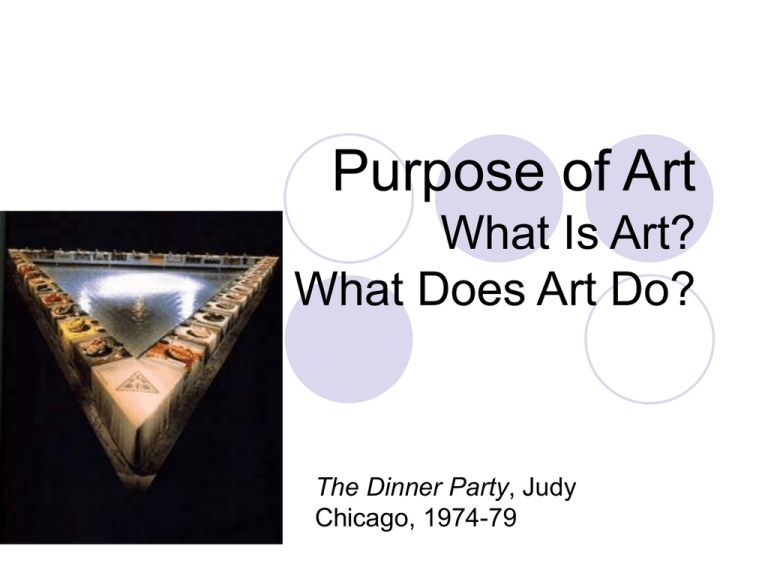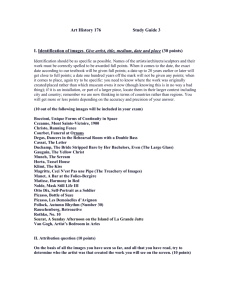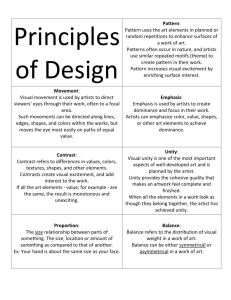Purpose of Art What does Art Do?
advertisement

Purpose of Art What Is Art? What Does Art Do? The Dinner Party, Judy Chicago, 1974-79 Modern Ideas about Art Artists of the past had different assumptions on the nature of their tasks. The purpose of their artwork was specific and much different than artists working today. The audience was usually very specified as well, and the viewers had different ideas about the art’s purpose as well as how they considered the artist. Today: We take it for granted that the artist’s task is to pursue his or her own vision of art. Art today is seen as a way for the artist to express his or her own ideas, insights and feelings. We assume art is for anyone that takes an interest in it and have galleries and museums, books and magazines dedicated to sharing art with the world. Art and Beauty Beauty is deeply linked to our thinking about art. During the 18th century, when the “category” of ART came into being beauty and art were discussed together. art was considered something that gave one pleasure to look at- just as beauty does. This was an intellectual pleasure-one achieved Through disinterested contemplation. Edward Weston, Cabbage Leaf, 1931. Is all Art “beautiful”? Some theories link beauty to formal qualities such as symmetry, simple geometric shapes and pure color. Francisco Goya. Chronos Devouring One of His Children, c. 1820-22. Originally a wall painting in Goya’s house. Art can be beautiful… But it can also inspire sadness, horror, pity, awe and a full range of other emotions. The common thread in each case is that we find the experience of looking to be valuable for its own sake Art makes looking worthwhile. Art can be beautiful, but not all Art tries to be beautiful and beauty is not a requirement of Art. Giovanni Bellini, Pieta, c. 1500-05, Oil on Wood, 25’ X 35” Representational vs. Abstract Not only does art not have to be “beautiful” it also does not have to faithfully represent “real life”. Louise Bourgeois, Woman with Packages, Bronze, 1949 65 x 18 x 12” Louise Bourgeois Abstracted the visual impact of a woman standing all the way to a slender vertical column topped by an egg shaped element. Woman with Packages belongs to a series of sculptures that she called Personages. A personage is a fictional character, as in a novel or play. Bourgeios often arranges them in groups or pairs- implying a story for them. Why Abstract Art? Since the invention of photography artists have questioned whether the role of the artist paint subjects that the “camera lens can establish so clearly” ? Paintings that refer clearly to the visible world are considered representational. Painting in a way that is very faithful to the visual experience, recording how forms are revealed by light and shadow, how bodies reflect inner structure of bone and muscle, how fabric drapes of bodies and objects and how gravity make weight feel is called naturalistic. Pablo Picasso, First Communion, 1895 Representational (and Naturalistic) Pablo Picasso, Seated Woman, 1910 Abstract Picasso could paint realistically but he chose not to. He was part of a courageous generation of artists that opened up a new territory for artists. These artists were trained in the traditional arts (representational) yet they chose to try something new. These artists were the first generation to take photography for granted. Before photography any and ALL images in the world were created by hand. Since the invention of photography- some artists felt free to do other things. On the other end of the spectrum- there is Trompe l’oeil. Duane Hanson, Flea Market Duane Hanson, Tourist Couple, Autobody filler, polychromed, mixed media with accessories, life size Trompe l’oeil- To fool the eye Nonrepresentational Art Artists at the beginning of the 20th century turned their backs on the visual world altogether as a starting point for art. Nonobjective or nonrepresentational artists like Vasily Kandinsky compared art to music. “Music”, Kandinsky said,”does not represent anything outside of itself.” Kandinsky’s paintings are composed of colors and shapes arranged on a flat surface. Composition IX Vasily Kandinsky, 1936 (120 Kb); Oil on canvas, 44 5/8 x 76 3/4 in What Is Art? * Visual Creation that enhances our daily lives * Art encompasses many meanings including ability, process, and product *Ability- the human capacity to make things of beauty and things that stir us = creativity *Process- drawing, painting, sculpting, designing *Product- art as the completed work-an etching, a bowl, a sculpture, an installation Ease, 1987, Bridget Riley Personal experience/encounters with art are: unique and depend upon the nature of the individual, the time, place and culture of the artwork and the viewer. Two Fridas, Frida Khalo, 1940 The language or vocabulary of art includes the Elements ofArt Principles of Design Style of the Artist Form and Content The Temptation of Adam and Eve, Sistine Chapel, Michelangelo, 1510 Art Helps Us Understand History Examining a work in its historical, social, and political context will enable you to have a more meaningful dialog with that work. The creative process has been intertwined with world events and individual personalities There are many different opinions on the purpose of art: No purpose, exists for its own sake Transcends the human occupation with usefulness Beauty and wonder Some think in trying to analyze art, you lose sight of its meaning. Just What Is It That Makes Today’s Homes So Different, So Appealing, Richard Hamilton, Collage, 1956 Understanding and appreciation of art can be enhanced by asking Why was this created? What is its purpose? There may not be a single definition of art, but we can come to understand art by knowing what art does. Themes of Art Themes do not reduce art into neat categories- they provide a framework for exploring how complex a form of expression it can be. Art enhances our daily lives Art helps us envision the sacred realm, helps us honor it and communicate with it. Art has served to project the presence and authority of rulers to the people throughout their lands. (Art depicts politics and social order) Art reveals the Here and Now Art Expresses Fantasy and Invention Art reflects the Human Experience Art tells stories and histories Art speaks of nature and our relationship to it Art can be made for the sake of ART What Does Art Do? * Art Enhances Our Daily Life Artists imitate nature's beauty or aim to improve upon nature by developing an idealized form. The Railroad, Edouard Manet, 1872 Beauty is in the eye of the society's beholder Depending on the time period, geographical location and society- the “beauty” in Art varies greatly. A miniature, Kishengarh, Jaipur, Rajasthan *Art Enhances Our Daily Life Art delights our senses-turns ordinary environments into pleasurable havens Paintings, murals, tapestries, sculptures, fountains, stained glass, mosques, cathedrals San Francisco Mural, 1931, Diego Rivera Whatever other functions works of art may serve, they can change our environment: *Art Reveals the Here and Now Art is a powerful tool-can be used to replicate reality. Literal truths or describe truths about humanity or themselves. (selfportraits, photographs) Guernica, Pablo Picasso, 1937 Seurat, Georges For Seurat, painting in his “here and now” meant including Bathers at Asnieres the factories in the background of this tranquil beach scene. 1883-84 (retouched 1887) Seurat found beauty in the factories and dignity in ordinary 79 x 118 1/2 in workers. Subject: signs of the times, a mix of high art imagery (Sistine ceiling in the upper left) and low art, popular culture references (sunkist oranges); nature (the bald eagle) and culture (the red industrial landscape in the lower right); America, the beautiful, in all its urban sprawl splendor. Context: transition between the Abstract Expressionism of the 50s and the Pop Art of the 60s; brings back subject matter by shifting art away from abstraction and the studio and toward the outside world becomes a kind of modern-day history painter, reporting on the changing times. Robert Rauschenburg Windward, 1963 Oil and silkscreened ink on canvas 8’ x 5’ 10” Art is a powerful tool for revealing truth Art can be used to replicate reality in the finest detail Art can also reveal truths about humanity or about the artist themselves. Chuck Close, Big SelfPortrait , 1967-1968 Negress Notes 1996, Kara Walker *Art Expresses Religious Beliefs Symbolism is important in almost all religious art. Art has long been used to express hopes for fertility, to propitiate the gods, to represent great events, and values and to commend heavenward the souls of the departed. Buildings are also vehicles for expressing beliefs and emotions. In western culture, examples of this are found in Romanesque and Gothic churches of the late Middle Ages The Sacred Realm The sacred realm can not be seen with human eyes, yet artists throughout the ages have been asked to create images of gods, goddesses, angels, demons and all manner of spirit beings. Religious images may serve to focus the thoughts of the faithful by giving concrete form to abstract ideas. Inupiaq, Ceremonial Death Mask Greek god Standing Buddah (India) The End of Modernity, Josiah McElheny, 2006 Crucified Christ, Susan Young *Art Expresses Fantasy and Invention Art serves as a vehicle by which artists can express their innermost fantasies. Some artists labor to reconstruct reality and commemorate actual experiences- others vent their imaginary inner lives. Many fantasies, dreams, day-dreams, and objects/landscapes conceived by the imagination are created in an attempt to capture the inner self. Many 20th century artists looked to psychoanalytic writings of Sigmund Freud and Carl Jung to help them reach their inner thoughts. Marc Chagall was a Russian- born French artist who used his work to recreate memories of his childhood. I and the Village, Marc Chagall 1911 The Garden of Earthly Delights, Hieronymus Bosch, c. 1505-10 Oil on panel, 7 ‘ x 6’ (center panel) *Art Records and Commemorates Experiences (tell stories and histories) "Art is not a handicraft; it is the transmission of feeling the artist has experienced"- Leo Tolstoy From prehistoric cave paintings to the Vietnam Memoria in Washington, D.C.- art has been used to inform future generations. *Art Immortalizes (History/Stories) Warhol saw commercialization and marketing as art forms in themselves. He set up his studio to be like a factory (he called it the "Art Factory") where he manufactured works like any other product. He also realized that personalities were also products that could be marketed. He practiced this using cultural icons like Elvis Presley and Marilyn Monroe. Turquoise Marilyn, 1962, Andy Warhol Andy Warhol Art can defy mortality by creating a work that will keep the public conscious of a person long after their death (ex. Benjamin Franklin) *Art Reflects the Human Experience Artists frequently record the activities and objects of their time and places, reflecting contemporary fashions and beliefs as well as states of crafts and sciences. Edward Hopper, Richard Hamilton. Edward Hopper and many of the American artists of the 1930's and 40's were interested in creating an identity that would buoy the American spirit during those times of war and hardship. Hopper was loosely associated with the American Regionalist movement, a group of artists who were interested in reflecting the strength and character of America. Nighthawks, Edward Hopper, 1942 *Art Depicts Politics and Social Order Artists seek analogies in apocalyptic events such as war, famine, or natural Guernica, Pablo catastrophes Picasso, 1937 *Art Protests Injustice and Raises Social Consciousness Guerrilla Girls Eugene Delacroix (French Romanticism) "Liberty Leading the People", 1830 Artists use their creativity to persuade others to join their cause. Guerrilla Girls Liberty Leading the People, Eugene Delacroix, 1830 Art depicts nature and our relationship to it. Robert Smithson, Spiral Jetty, 1970, rock, salt crystals, earth, Algae, coil length 1500’ *Art Meets the Needs of the Artist Art for Art Art can permit individuals to earn a living and to attain achievement American painter Barnett Newman gave his reason for painting, “ To have something to look at”. Art is an activity we have to come to pursue for its own sake. Art can be its own theme.





